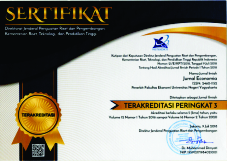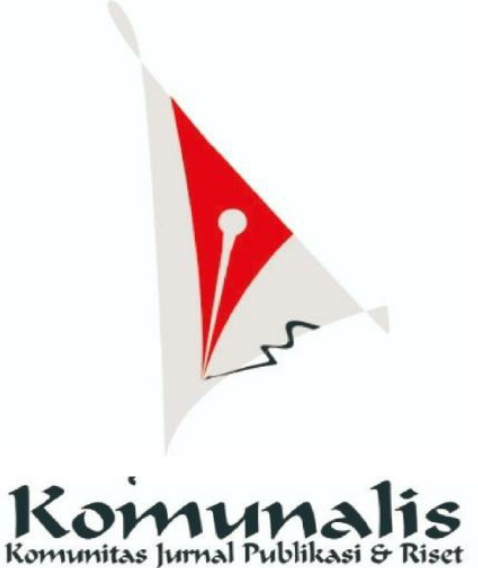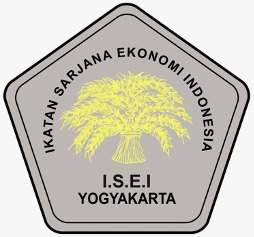Comparative Analysis of the Determinant Factors of Return on Assets between Islamic Commercial Banks (BUS) and Islamic Business Units (UUS)
Downloads
Abstract: This study aimed to analyze and compare the factors that affect the return on assets (ROA) of Islamic commercial banks (BUS) and Islamic business units (UUS). This study's independent variables are NPF, FDR, and MSMEs. The study used the quantitative method, with multiple regression approaches in analyzing the research data. The results of this study show that the BUS NPF has a negative and significant impact on the BUS ROA; the BUS FDR has a positive and insignificant impact on the BUS ROA; the BUS MSMEs portion of the BUS loan distribution has a negative and insignificant impact on the BUS ROA; the UUS NPF has a negative and significant impact on the UUS ROA; the UUS FDR has a positive and significant impact on the UUS ROA; and the MSMEs' portion of the UUS loan distribution has a positive and significant impact on the UUS ROA.
Keywords: BUS, UUS, Return on Asset, Non-Performing Financie, Financing to Deposit Ratio, MSME financing
Analisis Perbandingan Determinan Faktor Return on Asset antara Bank Umum Syariah (BUS) dengan Unit Usaha Syariah (UUS)
Abstrak: Penelitian ini bertujuan untuk menganalisa perbandingan variabel-variabel yang mempengaruhi return on asset pada Bank Umum Syariah (BUS) dengan Unit Usaha Syariah (UUS). Adapun variable-variabel bebas yang digunakan pada penelitian ini adalah non performing financing, financing to deposit ratio dan porsi penyaluran pinjaman usaha mikro, kecil dan menengah (UMKM). Metode yang digunakan adalah kuantitatif dengan pendekatan regresi berganda dalam melakukan analisa penelitian ini. Hasil dari penelitian ini diketahui bahwa NPF BUS berdampak negatif dan signifikan terhadap ROA BUS; FDR BUS berdampak postif dan tidak signifikan terhadap ROA BUS; porsi penyaluran pinjaman UMKM BUS berdampak negatif dan tidak signifikan terhadap ROA BUS; NPF UUS berdampak negatif dan signifikan terhadap ROA UUS; FDR UUS berdampak positif dan signifikan terhadap ROA UUS; Porsi penyaluran pinjaman UMKM UUS berdampak positif dan signifikan terhadap ROA UUS.
Kata kunci: BUS, UUS, ROA, NPF, FDR, Pembiayaan UMKM
Downloads
Abd Razak, A. H. (2019). Multiple Sharia' board directorship: a Maslahah (public interest) perspective. Journal of Islamic Marketing, 11(3), 745–764. https://doi.org/10.1108/JIMA-10-2018-0185.
Afkar, T. (2017). Influence Analysis Of Mudharabah Financing And Qardh Financing To The Profitability Of Islamic Banking In Indonesia. AJIE - Asian Journal of Innovation and Entrepreneurship, 02(03), 340–351. Retrieved from https://journal.uii.ac.id/ajie/article/view/8355/7503.
Agur, I. (2012). Credit rationing when banks are funding constrained. North American Journal of Economics and Finance, 23(2), 220–227. https://doi.org/10.1016/j.najef.2012.01.002.
Alam, A., Dewi Permata Sari, & Boby Habibi. (2020). Penyuluhan Etika Hutang Piutang Dalam Islam Di Dusun Bendosari Kabupaten Sukoharjo. Amaliah: Jurnal Pengabdian Kepada Masyarakat, 4(1), 1–13. https://doi.org/10.32696/ajpkm.v4i1.324.
Almunawwaroh, M., & Marliana, R. (2018). Pengaruh Car, Npf Dan Fdr Terhadap Profitabilitas Bank Syariah Di Indonesia. Amwaluna: Jurnal Ekonomi Dan Keuangan Syariah, 2(1), 1–17. https://doi.org/10.29313/amwaluna.v2i1.3156.
Amidu, M., & Wolfe, S. (2013). The impact of market power and funding strategy on bank-interest margins. European Journal of Finance, 19(9), 888–908. https://doi.org/10.1080/1351847X.2011.636833.
Badawi, A., & Hidayah, N. (2018). The effect of liquidity, quality of productive assets and company size on the operational risk disclosure of sharia commercial bank (study on sharia banking in indonesia). European Journal of Business and Mangement, 10(18), 1–10. Retrieved from https://iiste.org/Journals/index.php/EJBM/article/view/42974/44459.
Beekun, R. I., & Badawi, J. A. (2005). Balancing ethical responsibility among multiple organizational stakeholders: The Islamic perspective. Journal of Business Ethics, 60(2), 131–145. https://doi.org/10.1007/s10551-004-8204-5.
Bukhari, S. A. A., Hashim, F., & Amran, A. Bin. (2020). Determinants and outcome of Islamic corporate social responsibility (ICSR) adoption in Islamic banking industry of Pakistan. Journal of Islamic Marketing. https://doi.org/10.1108/JIMA-11-2019-0226.
Cebeci, I. (2012). Integrating the social maslaha into Islamic finance. Accounting Research Journal, 25(3), 166–184. https://doi.org/10.1108/10309611211290158.
Chotib, A., & Utami, W. (2016). Studi Kinerja PT BNI Syariah Sesudah Pemisahan (Spin Off) dari PT Bank BNI (Persero) Tbk. Akuntabilitas, 7(2), 94–108. https://doi.org/10.15408/akt.v7i2.2661.
DeFond, M. L., Raghunandan, K., & Subramanyam, K. R. (2002). Do non-audit service fees impair auditor independence? Evidence from going concern audit opinions. Journal of Accounting Research, 40(4), 1247–1274. https://doi.org/10.1111/1475-679X.00088.
Demirgí¼í§-Kunt, A., & Huizinga, H. (2010). Bank activity and funding strategies: The impact on risk and returns. Journal of Financial Economics, 98(3), 626–650. https://doi.org/10.1016/j.jfineco.2010.06.004.
Dusuki, A. W. (2008). Understanding the objectives of Islamic banking: a survey of stakeholders' perspectives. International Journal of Islamic and Middle Eastern Finance and Management, 1(2), 132–148. https://doi.org/10.1108/17538390810880982.
Erlangga, O. P., & Mawardi, I. (2017). Pengaruh Total Aktiva, Capital Adequacy Ratio (CAR), Finance To Deposit Ratio (FDR) Dan Non Performing Financing (NPF) Terhadap Return On Assets (ROA) Bank Umum Syariah Di Indonesia Periode 2010-2014. Jurnal Ekonomi Syariah Teori Dan Terapan, 3(7), 561. https://doi.org/10.20473/vol3iss20167pp561-574.
Fathonih, A., Anggadwita, G., & Ibraimi, S. (2019). Sharia venture capital as financing alternative of Muslim entrepreneurs: Opportunities, challenges and future research directions. Journal of Enterprising Communities, 13(3), 333–352. https://doi.org/10.1108/JEC-11-2018-0090.
Hassan, A., & Syafri Harahap, S. (2010). Exploring corporate social responsibility disclosure: the case of Islamic banks. International Journal of Islamic and Middle Eastern Finance and Management, 3(3), 203–227. https://doi.org/10.1108/17538391011072417.
Hidayah, N., Badawi, A., & Nugroho, L. (2019). Factors Affecting The Disclosure of Sustainability Reporting. International International of Commerce of Commerce and and Finance, 5(2), 219–229. Retrieved from http://oaji.net/articles/2019/2748-1570516215.pdf.
KNKS, K. N. K. S. (2019). Global Islamic Finance Report 2019 places Indonesia in the Top Position in the Global Islamic Financial Market. Jakarta. Retrieved from www.knks.go.id.
Nastiti, N. D., & Kasri, R. A. (2019). The role of banking regulation in the development of Islamic banking financing in Indonesia. International Journal of Islamic and Middle Eastern Finance and Management, 12(5), 643–662. https://doi.org/10.1108/IMEFM-10-2018-0365.
Nugroho, L., Mastur, A. A., Harnovinsah, & Aryanti, W. (2020). The Contribution of Islamic Bank in Poverty Alleviation. Al-Ahkam Jurnal Pemikiran Hukum Islam, 30(1), 19–38. https://doi.org/10.21580/ahkam.2020.30.1.5387.
Nugroho, L., & Nugraha, E. (2020). The Role of Islamic Banking and E-Commerce for The Development of Micro, Small, and Medium Entrepreneur Businesses. Business, Economics and Management Research Journal - BEMAREJ, 3(1), 11–24. Retrieved from https://dergipark.org.tr/en/download/article-file/1084680.
Nugroho, L., Utami, W., Sukmadilaga, C., & Fitrijanti, T. (2017). The Urgency of Allignment Islamic Bank to Increasing the Outreach. International Journal of Economics and Financial Issues, 7(4), 283–291. Retrieved from https://www.econjournals.com/index.php/ijefi/article/view/4493/pdf.
Nugroho, L., Villaroel, W., & Utami, W. (2018). The Challenges of Bad Debt Monitoring Practices in Islamic Micro Banking. European Journal of Islamic Finance, 11, 1–11. Retrieved from http://www.ojs.unito.it/index.php/EJIF.
Prasetiyo, L. (2012). Perkembangan Bank Syariah Pasca UU 21 Tahun 2008. Al-Tahrir: Jurnal Pemikiran Islam, 12(1), 43. https://doi.org/10.21154/al-tahrir.v12i1.46.
Rammal, H. G., & Zurbruegg, R. (2007). Awareness of Islamic banking products among Muslims: The case of Australia. Journal of Financial Services Marketing, 12(1), 65–74. https://doi.org/10.1057/palgrave.fsm.4760060.
Riyadi, S., & Yulianto, A. (2014). Pengaruh Pembiayaan Bagi Hasil, Pembiayaan Jual Beli, Financing To Deposit Ratio (Fdr) Dan Non Performing Financing (Npf) Terhadap Profitabilitas Bank Umum Syariah Di Indonesia. Accounting Analysis Journal, 3(4), 466–474. https://doi.org/10.15294/aaj.v3i4.4208.
Wibowo, E. S., & Syaichu, M. (2013). Analisis pengaruh suku bunga, inflasi, car, bopo, npf terhadap profitabilitas bank syariah. Diponegoro Journal of Managemen, 2(2), 10–19. Retrieved from https://ejournal3.undip.ac.id/index.php/djom/article/view/2651.
Widigdo, A. M. N., Imin, M., & Fahmi, I. (2016). Business Process Improvement of Funding: A Proposition to Increase the Performance of Indonesian Islamic Banking. Journal of Islamic Finance, 5(2), 66–79. https://doi.org/10.12816/0045118.
Widyaningrum, L., & Septiarini, D. F. (2015). Pengaruh Car, Npf, Fdr, Dan Oer Terhadap Roa Pada Bank Pembiayaan Rakyat Syariah di Indonesia. Jurnal Ekonomi Syariah Teori Dan Terapan, 2(12), https://doi.org/970–985. 10.20473/vol2iss201512pp970-985.
Yunus, D., & Muslimin, J. (2020). Debt in the Perspective of Islamic Law. Jurnal Syarikah : Jurnal Ekonomi Islam, 6(1), 22. https://doi.org/10.30997/jsei.v6i1.2187.















